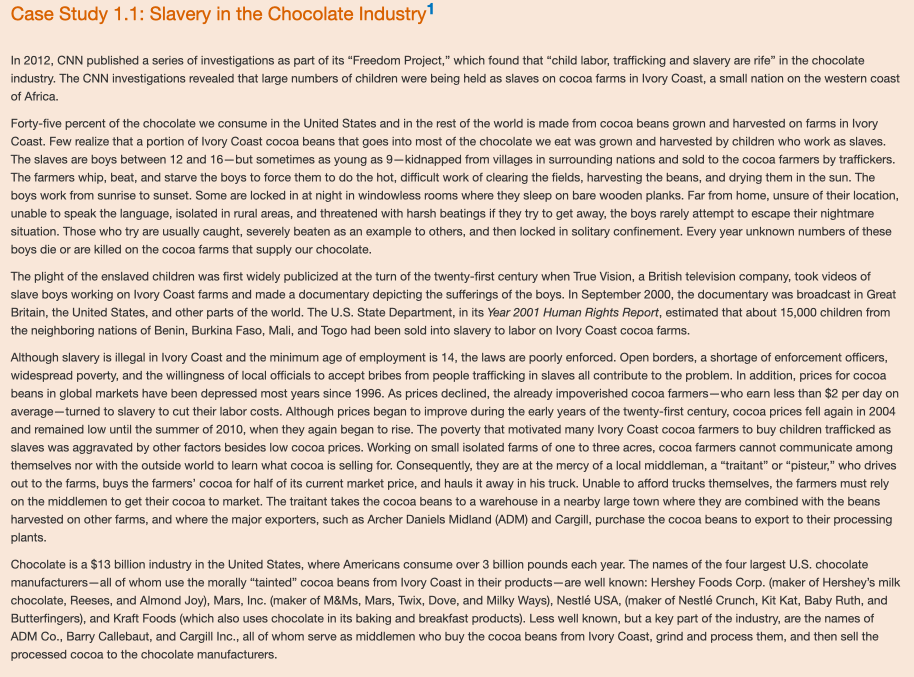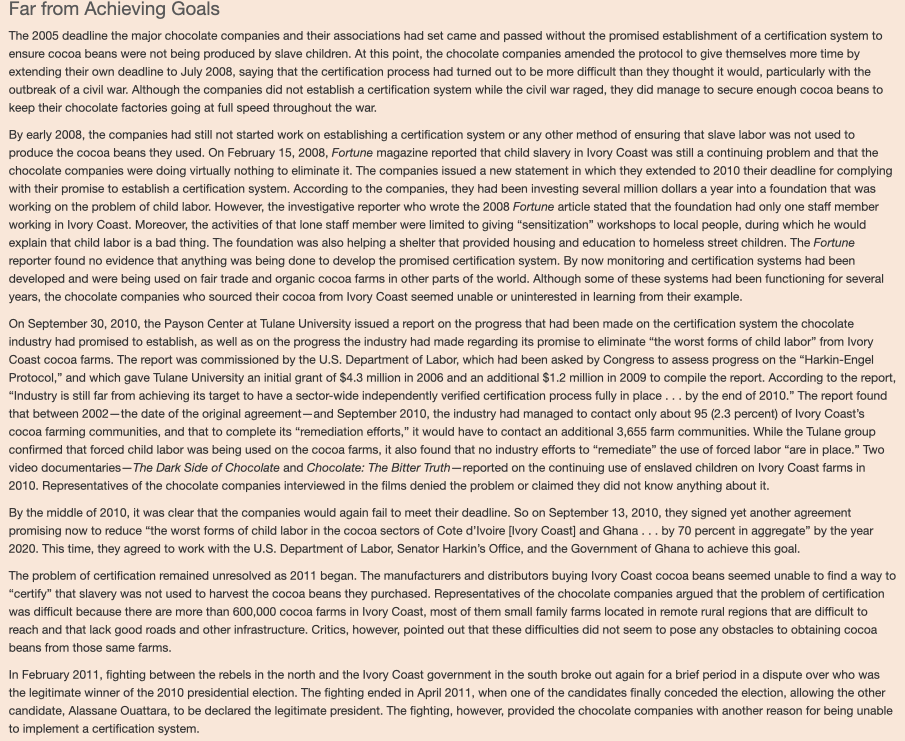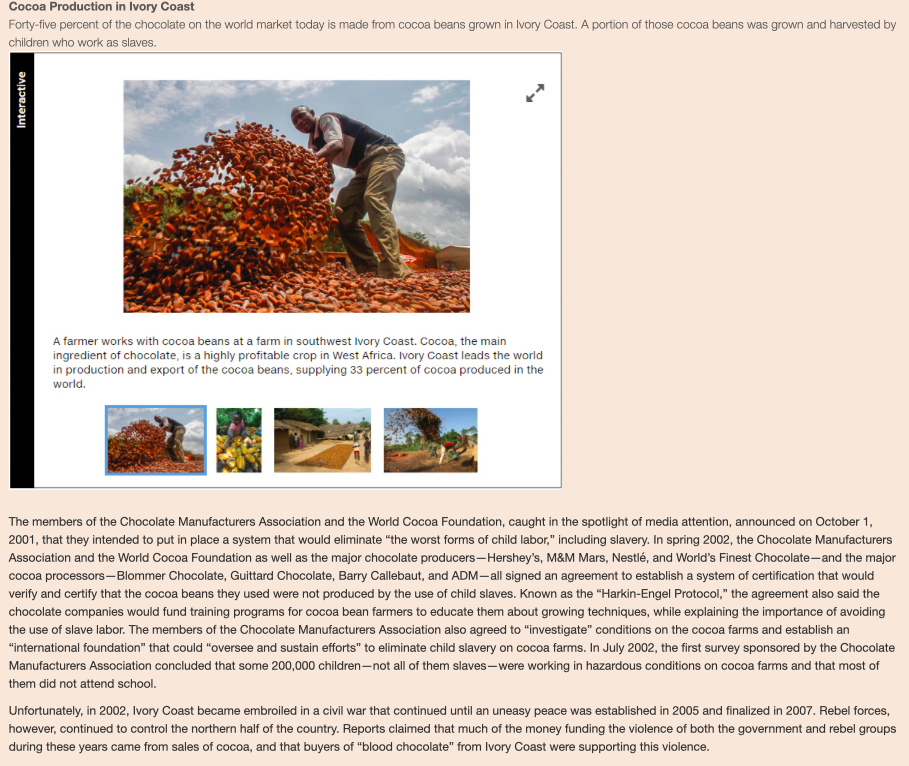Question
Cadbury was founded in 1824 by John Cadbury. It has the largeststake in the chocolate market in India for over decades now. 1.Cacao beans is
Cadbury was founded in 1824 by John Cadbury. It has the largeststake in the chocolate market in India for over decades now.


 1.Cacao beans is an importantingredient in the manufacture of the chocolates. This beans aregrown only in certain countries due to the climatic conditions. Thecountries include Latin America, Ghana & Ivory Coast and so on.Due to the increase in demand for the chocolate there was an highdemand for the cacao bean. However, the countries which grew thisbean had a very cheap labour as less as $2 per day for a laborer.This made the farmers introduce their children to the work to makea little extra money for their livelihood. This increased all overthe world in the farming and packing of cacao beans. As a resultthere was child labour seen in the supply chain of the Cadburymanufacturing scale.
1.Cacao beans is an importantingredient in the manufacture of the chocolates. This beans aregrown only in certain countries due to the climatic conditions. Thecountries include Latin America, Ghana & Ivory Coast and so on.Due to the increase in demand for the chocolate there was an highdemand for the cacao bean. However, the countries which grew thisbean had a very cheap labour as less as $2 per day for a laborer.This made the farmers introduce their children to the work to makea little extra money for their livelihood. This increased all overthe world in the farming and packing of cacao beans. As a resultthere was child labour seen in the supply chain of the Cadburymanufacturing scale.
The Cadbury chocolates are consumed by children all over theworld.
1)According to you, which model can be used to sort this issueof child labour in the supply chain?
2) Suggest a few changes which can abolish childlabour in such companies?
3) Problem/ Situation: explain the problem in two or threesentences, what you understood from this selected case study?
4) Solution: explain the solution/conclusion in two or threeliner, what you take away from the method?
5) Examples of methods are: ?STATE?, ?SMART?,?unfreeze-change-refreeze? etc. which Method is used: Mention thetool you will use?
6.select one method which they have learned in the subject?Professional Communication?.
Case Study 1.1: Slavery in the Chocolate Industry In 2012, CNN published a series of investigations as part of its "Freedom Project," which found that "child labor, trafficking and slavery are rife" in the chocolate industry. The CNN investigations revealed that large numbers of children were being held as slaves on cocoa farms in Ivory Coast, a small nation on the western coast of Africa. Forty-five percent of the chocolate we consume in the United States and in the rest of the world is made from cocoa beans grown and harvested on farms in Ivory Coast. Few realize that a portion of Ivory Coast cocoa beans that goes into most of the chocolate we eat was grown and harvested by children who work as slaves. The slaves are boys between 12 and 16-but sometimes as young as 9-kidnapped from villages in surrounding nations and sold to the cocoa farmers by traffickers. The farmers whip, beat, and starve the boys to force them to do the hot, difficult work of clearing the fields, harvesting the beans, and drying them in the sun. The boys work from sunrise to sunset. Some are locked in at night in windowless rooms where they sleep on bare wooden planks. Far from home, unsure of their location, unable to speak the language, isolated in rural areas, and threatened with harsh beatings if they try to get away, the boys rarely attempt to escape their nightmare situation. Those who try are usually caught, severely beaten as an example to others, and then locked in solitary confinement. Every year unknown numbers of these boys die or are killed on the cocoa farms that supply our chocolate. The plight of the enslaved children was first widely publicized at the turn of the twenty-first century when True Vision, a British television company, took videos of slave boys working on Ivory Coast farms and made a documentary depicting the sufferings of the boys. In September 2000, the documentary was broadcast in Great Britain, the United States, and other parts of the world. The U.S. State Department, in its Year 2001 Human Rights Report, estimated that about 15,000 children from the neighboring nations of Benin, Burkina Faso, Mali, and Togo had been sold into slavery to labor on Ivory Coast cocoa farms. Although slavery is illegal in Ivory Coast and the minimum age of employment is 14, the laws are poorly enforced. Open borders, a shortage of enforcement officers, widespread poverty, and the willingness of local officials to accept bribes from people trafficking in slaves all contribute to the problem. In addition, prices for cocoa beans in global markets have been depressed most years since 1996. As prices declined, the already impoverished cocoa farmers-who earn less than $2 per day on average-turned to slavery to cut their labor costs. Although prices began to improve during the early years of the twenty-first century, cocoa prices fell again in 2004 and remained low until the summer of 2010, when they again began to rise. The poverty that motivated many Ivory Coast cocoa farmers to buy children trafficked as slaves was aggravated by other factors besides low cocoa prices. Working on small isolated farms of one to three acres, cocoa farmers cannot communicate among themselves nor with the outside world to learn what cocoa is selling for. Consequently, they are at the mercy of a local middleman, a "traitant" or "pisteur," who drives out to the farms, buys the farmers' cocoa for half of its current market price, and hauls it away in his truck. Unable to afford trucks themselves, the farmers must rely on the middlemen to get their cocoa to market. The traitant takes the cocoa beans to a warehouse in a nearby large town where they are combined with the beans harvested on other farms, and where the major exporters, such as Archer Daniels Midland (ADM) and Cargill, purchase the cocoa beans to export to their processing plants. Chocolate is a $13 billion industry in the United States, where Americans consume over 3 billion pounds each year. The names of the four largest U.S. chocolate manufacturers-all of whom use the morally "tainted" cocoa beans from Ivory Coast in their products-are well known: Hershey Foods Corp. (maker of Hershey's milk chocolate, Reeses, and Almond Joy), Mars, Inc. (maker of M&Ms, Mars, Twix, Dove, and Milky Ways), Nestl USA, (maker of Nestl Crunch, Kit Kat, Baby Ruth, and Butterfingers), and Kraft Foods (which also uses chocolate in its baking and breakfast products). Less well known, but a key part of the industry, are the names of ADM Co., Barry Callebaut, and Cargill Inc., all of whom serve as middlemen who buy the cocoa beans from Ivory Coast, grind and process them, and then sell the processed cocoa to the chocolate manufacturers.
Step by Step Solution
3.51 Rating (151 Votes )
There are 3 Steps involved in it
Step: 1

Get Instant Access to Expert-Tailored Solutions
See step-by-step solutions with expert insights and AI powered tools for academic success
Step: 2

Step: 3

Ace Your Homework with AI
Get the answers you need in no time with our AI-driven, step-by-step assistance
Get Started


